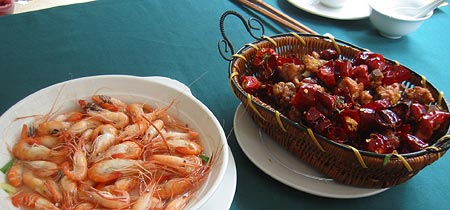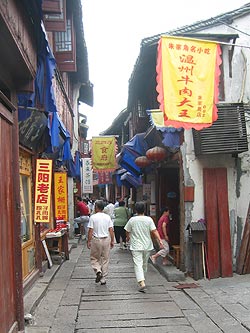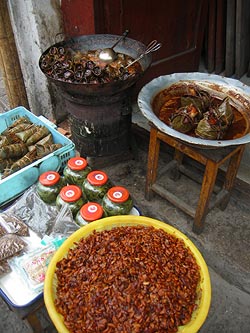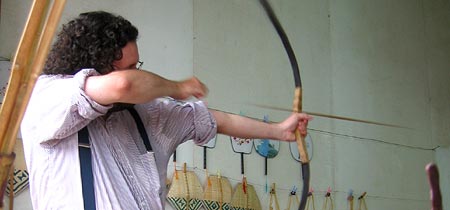To Qingpu and Back
I got on at Starbucks–from downtown Shanghai today.
Qingpu (pronounced “Ching-pu”) is a town near a small historical village on the banks of a river in the northwest area of Shanghai, and where Ken and I went today, guided by Ken’s student Fanny and her friend Sally (not their real names, but nicknames assumed for our convenience), who are native to that part of town.
Before going out to the village, we ate lunch at a nice place in town, a good number of medium-sized dishes that we all shared, and didn’t quite finish–apparently that’s not uncommon, maybe a slight show of prosperity, ordering more than you can eat. There was one dish, a spicy chicken, that was very attractive visually–but not quite so great to eat. Served in a basket, it had as many cooked peppers as chicken, but the chicken itself came in small pieces, and each one contained a small bone. A bit too much trouble.

After lunch, we headed out for the historic site. The village itself, named Zhu Jia Jiao, is supposed to be about 300 years old, and consists of a network of canals (with Venetian-style gondolas and their rowers) and small streets laden with tiny shops where their keepers beckon you endlessly to take a look at their wares. A lot of special region-specific pork dishes and other foods for take-home were available, but there were a wide variety of other shops, many with items for sale at $1~$3, including items that appeared like jade and ivory but obviously had to be fakes. Any number of tourist trinkets were available, but we were able to avoid purchasing–even with hawkers as persistent as those we found.
 |
 |
To give you an idea, as we entered the village, we approached the river and saw a sign that indicated that people would release fish into the river, probably for good luck. And several women approached, trying to sell us baggies filled with small fish, including goldfish. They followed us down a longish street–perhaps more persistent than usual because we were foreigners, a group that usually splurges more. They kept getting in front of us, practically insisting we buy some fish to release into the river. You just have to avoid eye contact and not make any moves to your wallet–these people tend to key in on any move that could indicate a sale.
One place we did indulge ourselves was a small archery room, where primitive bows and ten extremely primitive arrows were available for 5 Yuan. I took five shots, and Ken and Fanny shared the other five. Kind of fun, but the equipment was far from accurate, and most of the shots missed. But it was fun. We also indulged in a gondola ride for half an hour through the canals and under the main bridge on the river, and went into a temple which is supposed to bring good luck to those wishing to have children–not going for that purpose, of course.



On the way back, Ken and I took a “chicken bus,” as he’s come to call them. They’re buses that go along rural routes, which we needed as Qingpu is a few hours away from Ken’s place by bus. One time, when Ken took the bus, a passenger next to him had a bag on the floor, which soon began moving around of its own accord. The other passenger soon kicked the bag–and upon doing so, a loud squawk came from it, and Ken realized that there were chickens–plural–inside. Ergo, the “chicken bus.”
I didn’t see any chickens when we rode it back from Qingpu, but the ride was considerably slow, long and bumpy as hell–not the kind of ride I’d prefer to take every day. In theory, we were supposed to transfer to another bus midway, but neither Ken nor I felt like continuing that ride, and so we got another taxi (this time just 60 Yuan, or $7.50) to go back to Ming Hang, this time to midtown where we ate some McDonald’s (I wanted some predictability), and then walked back.
By this time, it was about 8:00 pm. On the way, we not only cruised by a lot of shops, but a ton of street vendors, selling, mainly, pirated DVDs and music CDs (a dollar apiece), jewelry, wallets, small pictures, and–for some reason–remote controls, like for your TV or VCR. A few strange stalls, like one run by a fellow who looked like he came from a Middle Eastern country, governing a huge mountain of nutcake of some sort–a salty mix of pieces of nuts in a gummy matrix, topped by candied walnuts, sweets, and dried fruit. A bizarre-looking concoction, probably popular somewhere in the world, but not quite our cup of tea.
An interesting day for the first full day in China, but not all that happened–a few more observations I’ll fill out in future posts, like the scrawling of spray-painted ads all over the place, a wealth of demolished buildings and uncleared rubble in many places, endless housing projects, ostentatious entrance signs, and a preponderance of bicyclists, scooter riders and three-wheeled bike barges on streets where traffic is more of a struggle than a flow.

Are you sure this is Qing Pu, Mate? Doesn’t look like it to me. Oh, well. I guess you can be excused if this was your first day in China.
Quite sure it’s Qingpu. We went to a little historical village or something–those aren’t the main city streets you’re looking at.
Hi,
How can I go to Qing Pu from downtown Shanghai?
Where can I catch this bus? Thanks?
Hey, I just visited there once about two years ago, I didn’t memorize the layout or nuthin’.
Hey Luis,
Was that really five years ago? Seems much more recent. We were both young and single then..
You may want to mention that one of those two QingPu girls in the photo is now my wife, living with me in California! Who’da thunk it?!
Ken:
Yep, 5 years, and about 10 kg for me.